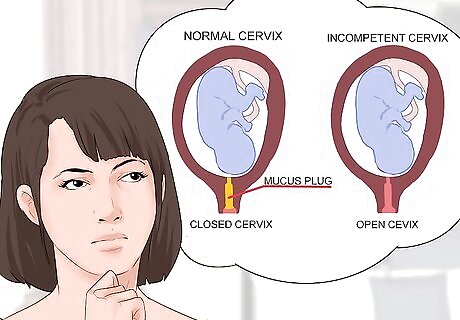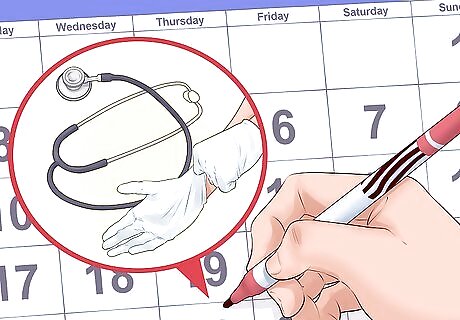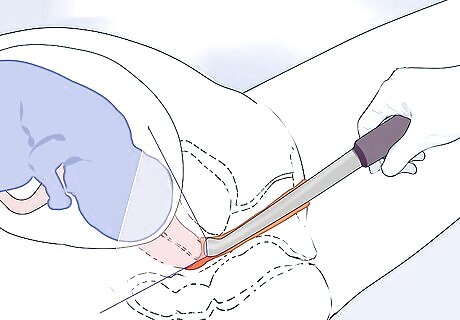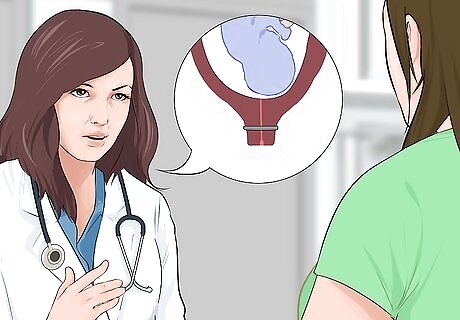
views
Working With Your Doctor to Prevent Incompetent Cervix

Understand what an incompetent cervix is. An incompetent cervix can also be referred to as a cervical insufficiency. This means that your cervix is found to have shortened, funneled, or dilated during your second trimester of your pregnancy. If the shape of the cervix changes, it creates a potential for miscarriage or preterm birth. Your cervix can change for many reasons, including (among other reasons): A history of cervical surgery and trauma, such as LEEPs, cervical cones, dilation of the cervix for pregnancy terminations, or D&C. A history of cervical lacerations with vaginal delivery. Congenital defects (anatomical anomalies).

Be aware that there are usually no symptoms. Cervical insufficiency often has no symptoms. The diagnosis must be made using a history of previous painless cervical dilations after the first trimester. During these procedures, you cannot have an infection, bleeding, or broken water. If you do experience symptoms, then some of your symptoms might include:: Abdominal cramping and lower back pain. You may experience mild cramps, often resembling menstrual cramps in the nature of the pain. Vaginal discharge. You may notice a change in the volume, color, and/or consistency of your vaginal discharge. Vaginal bleeding, although this is less common. Note that many cases are entirely asymptomatic. Therefore, if you have a history of the condition or of previous preterm births, or other risk factors for incompetent cervix, it is best to check in with your doctor on a regular basis. If you do have symptoms, they will most often present between 14 to 20 weeks gestation.

Schedule an appointment for an examination. Physical examination by a medical specialist (usually a gynecologist) is key to assessing the condition of your cervix. Things your doctor will look for include: Signs of "cervical effacement," which is when the cervix thins and stretches in preparation for birth. Signs of "cervical dilatation," which is when the opening of the cervix begins to widen in preparation for birth. The doctor may also do "provocative maneuvers," pushing on your uterus or asking you to do certain maneuvers that increase the pressure, to see if they can see any fetal membranes poking through with the application of pressure. If fetal membranes are visible, this is always a bad sign as it is a very high risk factor for preterm birth due to incompetent cervix.

Receive a transvaginal ultrasound. Using this technology, the doctor will be able to see if your cervix has dilated (or opened) in an abnormal way. At 18 to 22 weeks, you can have an ultrasound done to measure your cervix. Transvaginal ultrasound is usually the quickest and most reliable way in which incompetent cervix is detected and diagnosed as soon as possible. Early detection is key, because there are strategies doctors can use to prevent any further dilation of the cervix in order to ward off a preterm birth.

Discuss cerclage with your doctor. Something called a "cervical cerclage" is a type of suture that is placed below the internal opening of the cervix, and the cervix is tightened with sutures in a circular fashion (which means that the cervix is tightened up so that it can’t dilate—or open up—further than it should). This is actually the best way to prevent an incompetent cervix so if you have a high risk of developing this condition, talk to your doctor about this procedure. The sutures are put in 12 to 14 weeks into your pregnancy and removed around the 36 to 38 week mark of your pregnancy. They can also be placed at the time of diagnosis, which is called a rescue cerclage. These generally are not done after 25 to 26 weeks.

Discuss other preventative treatment options with your doctor. Cervical cerclage is the "gold standard" of preventative treatment for incompetent cervix. However, your doctor may suggest some additional treatment options. Ask about "vaginal pessary." This is a device that is inserted into the vagina to alter the position of the cervix so that the weight of the uterine contents do not push the cervix open prematurely.
Changing Your Lifestyle

Get more rest. Although complete bedrest is not yet scientifically proven as a reliable preventative treatment for incompetent cervix, most doctors recommend as much rest as possible if you are at risk of the condition in order to minimize the chances of premature birth. You can also try relaxation techniques such as: Practicing breathing exercises to keep yourself calm. Meditating each day to stay relaxed.

Avoid intense exercise if you have an incompetent cervix. Exercise is fine if you are pregnant, but if you have an incompetent cervix, then you should avoid all exercise that puts pressure on your body. You should avoid things such as running, gymnastics, and any sport that involves vigorous body movement. Your doctor may also recommend that you take time off work. This will depend upon what type of job you have, and the physical demands your line of work entails. It is definitely advisable to refrain from heavy lifting and other strenuous jobs.

Refrain from sexual intercourse. The act of coitus may place additional stress on your cervix, and could provoke further symptoms of incompetent cervix and a greater risk of preterm birth. Try exploring other forms of sexual activity that do not put the same strain on your cervix that intercourse does.

Schedule an appointment with your gynecologist for each month. If you are concerned that you might be at risk of developing an incompetent cervix, you should have a gynecologist check up on you at least once a month (if not more often) to make sure that the pregnancy is going smoothly.

Know that your baby can still be born healthy. It is important to remember not to panic if you are diagnosed with an incompetent cervix. You can still give birth to a happy, healthy baby but you must follow your doctor’s instructions.


















Comments
0 comment